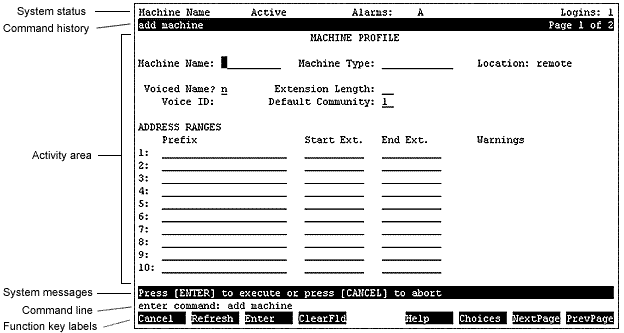|
This topic contains the following information about the Messaging
command prompt screen:
Layout of the Messaging command prompt screen
The following screen capture shows the basic layout of the Messaging
command prompt screen. See the Messaging command
prompt screen component descriptions table for information about
the screen's components.

Table: Messaging command prompt screen component
descriptions
| Component |
Description |
| System status |
This line displays system information.
Starting from the left, the system status line indicates:
- The Message Storage Server (MSS)
server name
- Voice mail status (Active or Inactive)
- Any active alarms:
- M = Major
- m = Minor
- A = Administrative
- w = Warning
- The number of people currently logged
in
|
| Command history |
This line displays the fully expanded
command typed in the command line, the current page number,
and the page count. For example, add machine Page 1 of 2.
If the active screen is a Help screen, this line displays
the title of the screen or field Help. For example, add machine
field help Page 1 of 1.
|
| Activity area |
This area displays:
- Data entry fields, which are used
to specify new or changed parameter values
- Display-only fields, which contain
current parameter values that cannot be changed from this
screen
- Report results, which display requested
system information
- Help for screens and fields, which
is activated with the F1 (Help) or F6 (Choices) keys
|
| System messages |
This line displays system feedback,
error messages, and prompts. For example, Command Successfully
Completed
|
| Command line |
This line is where you type commands
to gain access to a new screen or exit the Messaging command
prompt screen. |
| Function key labels |
This line shows labels for function
keys F1 through F8. Press the appropriate function key to activate
the function. |
Messaging command prompt screen standard function keys
Several function keys perform standard actions regardless of the
screen you are viewing. Other commands are unique to a particular
screen. The following table describes the purpose of each standard
function key.
| Function key
|
Purpose |
| F1 (Cancel) |
Aborts the current activity and
returns the cursor to the command line. When the cursor is
on the command line, F1 erases the entire contents of the
command line. On a Help screen, F1 returns to the screen on
which the help was requested.
Note: If you are using the Messaging command
prompt screen via the LAN with Internet Explorer, you might
experience difficulties such as the Windows help popping up
when you press F1 or the Messaging command prompt locking
up. These symptoms indicate that the Java Virtual machine
you are using is incompatible with the software. To alleviate
the problems, select the browser's Tools
> Internet Options... > Advanced
tab. Locate the Java (Sun) subheading and clear the checkbox.
Restart the browser to implement the changes. |
| F2 (Refresh) |
Repaints the screen. |
| F3 (Enter) |
Submits the information entered on
a screen for the action specified on the command line. When
the cursor is in the command line, F3 requests execution of
the command.
Note: Return has the same effect as F3 (Enter) when
the cursor is on the command line. On a screen, Return moves
the cursor forward from one field to the next. |
| F4 (Clear Field) |
Clears an entire field in a screen
or a single keyword from the command line. For example, if the
command line contains the command list machine and you
press F4, the command line changes to list. |
| F5 (Help) |
When the cursor is on the command line,
pressing this key is identical to typing the help command;
that is, it displays a screen explaining all the types of help
available for the Message Storage Server (MSS). When the cursor
is on a screen, this key requests help for the entire screen.
|
| F6 (Choices) |
When the cursor is on the command line,
this key requests a menu of valid entries for command line keywords.
Once a Choices menu is displayed, pressing F6 selects the highlighted
item from the menu.
When the cursor is on a screen, F6 requests help for the
particular field where the cursor appears. The field help
menu provides an explanation of the field and a list of valid
values or actions for the field. When a field menu is displayed,
pressing F6 again selects the highlighted item from the menu. |
| F7 (Next Page) |
Moves forward through multiple pages
of Messaging command prompt screens, reports, or help screens.
|
| F8 (Prev Page) |
Moves backward through multiple pages
of Messaging command prompt screens, reports, or help screens.
|
Top of page
|

